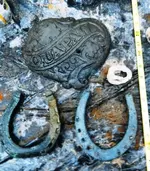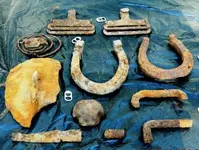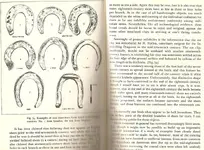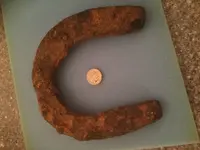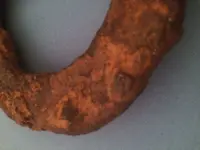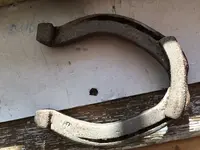Re: How do you date horseshoes?
TomPA said:
Horseshoes can be a little tough to date, as there were few changes over the years. However here are a few guidelines that I've come across.
The curving sides are called branches and the flat parts of those are the foot. Older branches (17th century into mid 1700's) tended to be crafted with a more inward curve that produced a "keyhole" look to the shape of the shoe. After this time period, the heels of the shoes were not as wide spread apart. The oldest shoes normally only had 6 nail holes in them and then in the later 1700's some had as many as 10 per side. (This obviously was a choice by the maker, so some later date shoes continued with fewer holes).
In the mid 1800's, the toe clip was introduced (the bump that your thumb goes on when pitching horseshoes).
The turned down ends at the end of the branches are called calkins. They started to show up on horseshoes in the 1800's as well.
Also, the grove that the nail holes are recessed into are called fullering. The oldest shoes did not have this feature. It showed up around 1750-75.
The problem with your dating is that probably 25 or 30 years ago I made horseshoes that weren't fullered. I haven't got any idea what the shoers today are doing, but i had a forge, was trained in a horseshoeing school, and if the horse required it, I made the shoe from bar stock and punched the holes. So did others. Not too long ago I watched a female horse shoer build a hand made horse shoe and she punched the nail holes. Saying that you can date the shoe because the heels are closer together on the older shoes rings false to also. Unless evolution, which I doubt, in the last couple of hundred years has altered the shape of the horses foot, then the shoes had to be made to fit the foot. A horse's foot that is shaped exactly the same today as 600 years ago. Unlike mules that have very straight sides on their feet, front and back, horses have different shaped feet front and back. Front shoes are more rounded, back shoes are more pointed. The photos in this post are both a front and a back shoe. Shoes made with narrow heels that didn't fit the hoof wall would cause the horse to come lame, so your theory of narrow heels on older shoes doesn't hold water, they didn't ride lame horses. Also, horses are individuals, no two are the same, so today if a horse has narrow heels on the front foot, then that is how the shoe is fit. Also, if on the front foot, a raggedy heal on the shoe, or one that extends beyond the heel of the foot causes two problems. First, the horse can step on the front shoe with his hind foot, and either trip or pull the shoe, or two, the poorly fit shoe will cause a shoe boil. That's a sore way up on the leg near the horses body, because when the animal lies down, the front foot is tucked up near the body and the poorly fit shoe rubs a sore. Also front feet tend to have narrower heels than the rear foot, so those shoes tend to be wider at the heels than the front, and the shoe can extend a bit behind the heel without any problems. Over the centuries more study has gone into horses feet than probably anything else. It's like the nursery rhyme that starts, "For want of a nail, the shoe was lost," and ends, "For want or the war the nation was lost, and all for the want of a horse shoe nail." Civilization arrived in this world on the back of a horse, and the horse wasn't lame. I'm sorry, but trying to date a horse shoe by shape or the number of nail holes is like trying to date a knife by the shape of the blade, it's not really possible. One last thing, when the horse puts his weight on the foot, the heels expand, which is very necessary for the health of the foot, if the heels can't expand, they become contracted, and the horse comes lame, so keeping the foot from expanding by running the nails that far back on the foot would cause the horse to come up lame in a short period of time. If you have found a shoe with that many nail holes, then there was something wrong with the animals foot that they were trying to correct, and it was more important that the foot be allowed to grow out than the expansion. In that case the horse probably wasn't used until the foot grew out, then the shoe was pulled and a proper one used. The bump on the toe of the shoe is called a "toe grab." A clip is drawn up on the toe by the blacksmith, and burned into the foot, and are used to take the strain off the nails. What you call "calkins," out west are called "corks," and are spelled caulks. The spikes on loggers boots are spelled and called the same thing. Anyhow, I've gone on too long. Good luck on dating horse shoes. I remember someone on Ebay was trying to sell a horse shoe that came off of one of Custer's horses at the Little Big Horn. I don't recollect him getting a bid. Unless he actually illegally dug the shoe on the battlefield, which fight took place over 140 or so years ago, but instead found it in the area, then how do you know it wasn't lost off of a horse in the next 100 plus years. Even if it was found on the actual battlefield, it could have been lost any time. To each his own, but I'm not going to buy a relic horse shoe, because like a rose, a shoe is a shoe, is a shoe. If you think you can pin a date on it, then go for it. All of that said, the shoes in this post are Diamond brand, and were used in this country in the mid 1950's, I know, because I nailed a lot of'em. i just googled diamond brand horse shoes, and they are still making the same shoe, and say they are the largest supplier in the world. So there you go.







